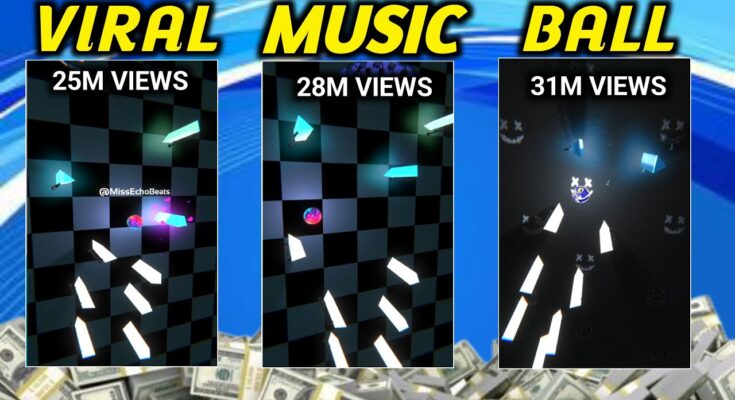In the age of short-form content, Bead Bounce Music Ball videos have become an eye-catching trend. These videos, often set to rhythmic music with mesmerizing visuals of beads bouncing in sync with sound, captivate viewers instantly. But how do you make your Bead Bounce Music Ball video go viral? In this article, we’ll walk you through everything you need to know—from equipment and setup to editing and marketing—to help you create engaging, share-worthy content.
What is a Bead Bounce Music Ball Video?
A Bead Bounce Music Ball video typically features a transparent or semi-transparent ball filled with beads. The ball is dropped or bounced on a surface, and the sound it makes is synced with music. Some creators add slow-motion effects, macro shots, or beat-matching transitions to enhance the visual impact.
Why Are They So Popular?
- Satisfying to Watch: The visual harmony of bouncing beads and music is aesthetically pleasing.
- ASMR Appeal: The subtle sounds of bouncing beads can trigger ASMR for many viewers.
- Short and Shareable: These videos are perfect for TikTok, Instagram Reels, and YouTube Shorts.
Step-by-Step Guide to Making Viral Bead Bounce Music Ball Videos
1. Gather the Right Materials
Before you begin filming, make sure you have:
- A Transparent Ball: Acrylic or silicone balls work best.
- Colorful Beads: Choose beads that are lightweight and reflect light.
- High-Speed Camera or Smartphone: Ideally, a phone that can shoot at 120 FPS or higher.
- Tripod or Stabilizer: To keep your shots steady.
- Lighting Setup: Natural lighting works, but ring lights or softboxes give more control.
- Editing Software: CapCut, Adobe Premiere Pro, or even mobile apps like InShot.
2. Set Up Your Filming Space
Choose a clean, distraction-free background. A white or black surface enhances bead visibility. Place the camera at a slight angle to capture both the bounce and bead movement clearly. Use slow-motion settings on your camera or phone to capture the bounce effectively.
Pro Tip: Use a soundproof surface or mat to minimize background noise and focus on bead impact.
3. Create Rhythmic Motion
Now comes the fun part—recording. Drop the ball in rhythm with your chosen soundtrack. Start with a beat or tempo in mind. Some creators use metronomes to match the bounce timing perfectly with the music.
Ideas to Try:
- Drop from different heights for sound variation.
- Use balls of different sizes.
- Add close-up or macro shots of bead motion.
4. Edit Like a Pro
Key Editing Tips:
- Slow Motion Sync: Match the ball’s bounce with the beat of the music.
- Zoom and Crop: Focus on the most dynamic parts of the bead movement.
- Transitions: Use fast cuts or zoom transitions for a dynamic feel.
- Music Selection: Use trending or royalty-free tracks that fit the mood.
- Sound Design: Enhance the bounce with added audio effects if necessary.
Editing apps like CapCut or VN Video Editor offer pre-made templates and beat sync features that make this easier.
5. Optimize for SEO and Discovery
To help your video go viral, you need to make it discoverable.
SEO Optimization Tips:
- Use Keyword-Rich Titles: Examples:
- “Satisfying Bead Bounce Music Ball Compilation”
- “Beads Bounce to Beat | Viral Music Ball Short”
- Hashtags: Use trending and relevant hashtags like:
#BeadBounce#SatisfyingVideo#MusicBall#ASMR#ViralReels-
Video Descriptions: Write a compelling and keyword-optimized description with relevant tags.
-
Thumbnails (for YouTube): Use bright, colorful thumbnails showing the ball mid-bounce.
6. Post on the Right Platforms
To maximize reach, post your video across multiple platforms:
- TikTok: Best for short, viral trends.
- Instagram Reels: Good for reaching broader lifestyle audiences.
- YouTube Shorts: Ideal for long-term discoverability.
- Facebook Reels: Emerging platform with strong engagement.
Timing Matters: Post during peak hours—typically between 6 PM and 9 PM local time or during lunch breaks on weekdays.
7. Engage Your Audience
Once your video is live:
- Ask a Question: “Which bounce was your favorite?”
- Use Polls or Stories: To increase interaction.
- Reply to Comments: Builds community and boosts engagement.
- Encourage Sharing: Add text overlays like “Share if you felt the bounce!”
8. Analyze and Improve
After posting, track how your video performs.
- Watch Time: How long are people staying?
- Likes/Shares: High engagement usually means you’re onto something.
- Comments: Look for feedback you can use to improve.
Use platform analytics (TikTok Pro, Instagram Insights, YouTube Studio) to gather data and refine your content strategy.
Tips to Make Your Video Go Viral
- Keep It Short: 15–30 seconds is the sweet spot.
- Use Trends: Adapt to trending songs or challenges.
- Tell a Micro-Story: E.g., “What happens when you drop 3 balls at once?”
- Experiment: Try new bead colors, bounce patterns, or music styles.
- Collaborate: Partner with other creators for double exposure.
Final Thoughts
Bead Bounce Music Ball videos combine creativity, rhythm, and visual satisfaction—perfect ingredients for viral content. With the right setup, editing, and SEO strategy, you can transform a simple concept into a viral hit. Whether you’re a beginner or an experienced creator, now is the perfect time to jump on this trend and start bouncing your way to millions of views.

